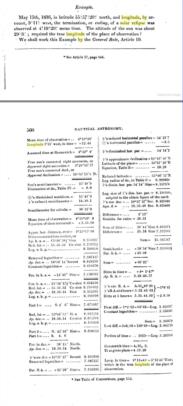
NavList:
A Community Devoted to the Preservation and Practice of Celestial Navigation and Other Methods of Traditional Wayfinding
From: Peter Blaskett
Date: 2024 Apr 14, 21:31 -0700
Jim Wyse, et al
I have located a method of finding the longitude using a solar
eclipse described by "Kerigan" in 'The Complete Mathematical
and General Navigation Tables'. Available here:
https://www.google.com.au/books/edition/The_Complete_Mathematical
_and_General_Na/l5IAAAAAMAAJ?hl=en&gbpv=1&dq=kerigan+longitude
+by+solar+eclipse&pg=PA531&printsec=frontcover
A fully worked example is given, beginning page 557, Problem XVI.
Using "EclipseWise.com" by Fred Espenak, the modern values of the
example are shown in file1.
Using Stellarium at 16:32:04, a Local Apparent Time of 4:23:18
is found.
EOT is 3m 57s So Local Mean Time is 4:19:21
Assumed diff long of 3d 11’ = 0:12:44 of time
Applied to LMT gives a UT of observation 16:32:05
Note: they still reckoned time from noon
This looks well with the modern value of 16:32:15
Kerigan’s calculation is laid out in file2 :
I have not yet begun to try and replicate this computation.
Also, I doubt that this is a method which would have been used by
Witchell to compute Cook's data. I'm confident he used something
other, but I haven't found it yet.
It's all a hunt in progress.








